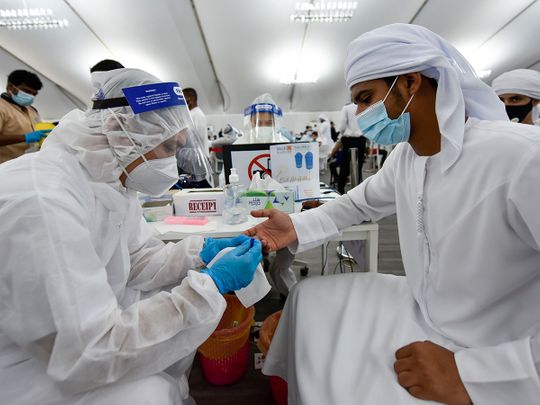
Dubai: COVID-19 and Influenza, both have a similar manifestation. So how do you differentiate between the two? Most importantly, if you have symptoms, when should you visit a doctor to get yourself checked in order to rule out a Coronavirus infection.
Take the case of an Indian family in Dubai who were worried sick about a cold and throat infection. Samina Khan, a third-year undergraduate student, said she thought she was infected with COVID-19 because she had a cold, dry cough and throat infection. “I pestered my mother to get a COVID-19 test done for me. But she did not budge. She also called a clinic and the doctors advised to wait a day or two for the symptoms to get worse and then only do a COVID-19 test. Luckily for me, it was a mild case of Influenza,” said Khan who took some herbal medicines to cure her symptoms.
Medical experts based in the UAE tell us just why people should not panic if they have a cold or a cough and when they must actually present themselves for COVID-19 screening.
Dr Leena Mahana Kapoor, senior specialist in internal medicine at Prime, Al Barsha Heights, said: “In current pandemic times, it is common to make a mistake in differentiating between a simple Influenza and COVID-19. But there is a way to differentiate between the two.”.
Explaining both conditions, Kapoor said: “Both cause respiratory illnesses — from asymptomatic to mild to a severe condition. Both are transmitted by contact, droplets and fomites too. But the main differentiating factor is the speed of transmission.” She said flu has a shorter mean incubation period from when you catch the virus to the illness being manifest. For example, the serial interval or the time taken for the virus to be transmitted from one person to another is three days for Influenza and five to six days for COVID-19. This means the flu virus travels faster.”
Kapoor added that the number of secondary infections generated from one infected patient to another is 2 to 2.5 for the COVID-19 virus, higher than that of flu. She also said another critical difference between the two is that while children are important drivers for Influenza, in case of COVID-19, children are usually infected from adults. “Mortality rate for COVID-19 patients is higher than that of flu, especially seasonal Influenza.”
Dr Salvin George, specialist, Internal Medicine, Medcare Hospital, Al Safa, said: “Another differentiating factor between COVID-19 and flu is that headache and body ache are stronger in COVID-19 infections. Besides, repeated tests are necessary to completely rule out COVID-19.”
When to test for COVID-19
George said: “Flu symptoms with a history of exposure to people with COVID-19 virus or if they have been to public places like malls, shops, Metro, buses or offices within the past week warrant a COVID testing.”
Dr Abhilash Ramachandran Nair, specialist, Internal Medicine, Aster Hospital, Al Qusais, said: “A doctor may occasionally be able to come to a conclusion on whether it is flu or COVID-19 based on physical examination. Investigations (tests) would be needed for an accurate diagnosis. Also, we have to bear in mind that a large proportion of COVID-19 cases and a significant proportion of flu cases can be asymptomatic or only minimally symptomatic. We also have to bear in mind that COVID-19 can be asymptomatic, especially since usage of masks have become widespread.
"History of close contact with an individual with known COVID-19 infection should prompt testing of vulnerable individuals such as those who are pregnant, elderly people or individuals with any serious heart disease, uncontrolled diabetes, certain chronic lung diseases, chronic liver disease, chronic kidney disease, immunocompromised conditions (because of certain medications or diseases) and people who are care givers for such individuals. Undiagnosed fever or cough in anyone should prompt a COVID-19 test as well."
Distinguishing between COVID-19 and flu a challenge for UAE doctors
According to Dr Ahmed Mohamed Abdelaal, consultant, Paediatrics, at Burjeel Hospital Abu Dhabi, as winter approaches, distinguishing patients with COVID-19 from those with flu will become a problem.
“Distinguishing COVID-19 from flu and other respiratory viral infections remains a challenge to clinicians. Although patients with COVID-19 are more likely than patients with flu to report fever, gastrointestinal and other clinical symptoms at the time of diagnosis, the two groups do have many overlapping clinical symptoms.”
Abdelaal added: “Influenza and COVID-19 are both contagious respiratory illnesses, but they are caused by different viruses. COVID-19 is caused by infection with a new Coronavirus (called SARS-CoV-2), while flu is caused by infection from the Influenza virus. Since some of the symptoms of flu and COVID-19 are similar, it may be hard to tell the difference between them based on symptoms alone, and testing may be needed to help confirm a diagnosis. Flu and COVID-19 share many characteristics, but there are some key differences between the two.”
At a glance: Differences between flu and COVID-19
Change in taste or smell or complete loss of these sensations, in case of COVID-19.
In case of a flu, typically, a person develops the symptoms anywhere between one and four days after catching infection. In case of COVID-19, a person generally develops the symptoms five days after being infected, but symptoms can appear as early as two days or as late as 14 days after a person is infected.
Most people with flu are contagious for about one day before they show symptoms.
In case of COVID-19, this is still under investigation.
The risk of complications for healthy children is higher in flu compared to COVID-19.
In cases of COVID-19, additional complications include blood clots in the veins and arteries of the lungs, heart, legs or brain and a multisystem inflammatory syndrome.












